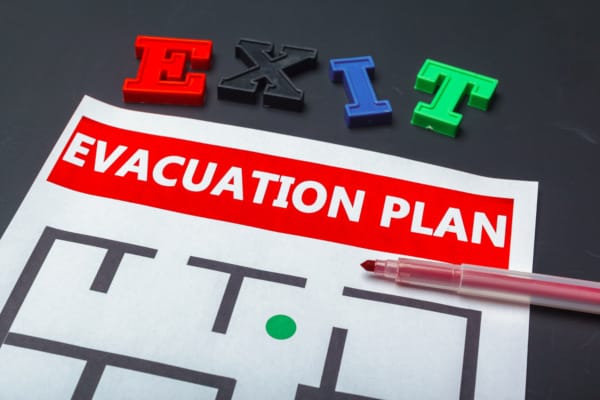Being ready for a home fire emergency means staying safe
House fires happen fast. According to the American Red Cross, the time between a smoke alarm sounding and it being too late to escape can be as little as two minutes.
House fires also cause vast amounts of damage every year. The National Fire Protection Association (NFPA) reports that a home catches on fire every 88 seconds. And these fires kill an average of seven people each day and injure 32 more.
Fire safety technology has improved dramatically, and the overall number of home fire deaths has decreased since 1980. And the minority of homes that are equipped with automatic fire sprinkler systems have the best defense. However, modern home-building techniques and materials can allow quicker fire ignition and spread, and the death rate from fires has increased by 10% since 1980. In other words, we now have fewer house fires, but they are more likely to be deadly.
That’s one reason you need a plan for home fire safety. In an emergency, you won’t have time to think about what to do! Check out this guide to get prepared.
Home fire safety starts with preparation and ends with the right tools. Shop the QRFS selection of fire blankets and ABC fire extinguishers to protect your home.
1. Financial preparedness
Besides the danger to life and limb, house fires threaten your belongings and financial security. Losing possessions and a home is an enormous financial and emotional hardship.
While nothing can eliminate that stress, you can take steps to make yourself more financially secure. First, make sure you have home insurance and review the policy to determine whether it covers fires—and to what extent. Second, ensure you protect or have access to essential documents after a fire—because you probably won’t have time to grab them when you evacuate.
Maintain homeowner’s and fire insurance
While no state requires homeowner’s insurance, most lenders require some form of policy before issuing a mortgage. Similarly, a landlord may require tenants to have renter’s insurance.
Whether you rent or own, good insurance is essential to getting back on your feet after a fire, as well as other types of disasters. It can help pay for damage to your home (if you own it) and any belongings. Plus, policies may cover some medical expenses and things like hotel stays if the residence is uninhabitable.
Don’t forget to read your insurance policy to make sure it covers fire, smoke, and water damage. If you live in an area prone to wildfires, for example, homeowner’s insurance may not automatically carry protections against these events. In that case, you’ll have to purchase an additional fire insurance policy or umbrella insurance. And remember, it pays to create an inventory of items with pictures if you may need to replace valuable belongings.
Protect your essential documents
A fire can destroy everything you own. If you lose crucial documents—credit cards, insurance details, bank details, driver’s licenses, passports, social security cards, birth certificates, etc.—you’ll have an even harder time recovering.
A good for securing documents is placing key items in a water-tight and fireproof cabinet or safe, to be recovered when it’s safe to return to your house.
The alternative is keeping essential documents off-site. Bank safe deposit boxes are one way to secure crucial documents. But in the age of cloud computing, a digital backup is a viable option for most items. While you may still need to protect original hard copies of specific documents, scanning and storing most things on an encrypted cloud server gives you permanent access from anywhere.
2. Fire preparedness and prevention
“An ounce of prevention is worth a pound of cure” is a saying that’s especially true in fire protection. Smoke, flames, and water (from extinguishing a fire) are so destructive that it’s far better to never need a fire extinguisher, sprinkler system, escape plan, homeowner’s insurance, or the fire department.
To prevent fires in the home, focus on the major causes of fire ignition, death, and property damage. In addition, make sure your smoke alarms work, practice safe cooking, and maintain all gas and electrical systems.
Ensure smoke detectors are ready to go
Smoke alarms undoubtedly save lives. According to NFPA, the death rate per 1,000 home fires is about twice as high in homes without working smoke alarms. These devices provide enough advanced warning to either fight small fires (if it’s safe to do so) or escape. Thus, maintaining smoke detectors is core to fire prevention and preparedness.
First, make sure your smoke alarms are installed where you need them. Minimally, NFPA recommends devices inside every bedroom, outside every sleeping area, and on every level of a home.
Second, check the age of your smoke detectors, especially if you’re moving into a new home. The maximum lifespan of a smoke detector is about 10 years. If you don’t remember when they were installed, you can check the back or the inside of smoke detectors for a stamp or sticker that shows when they were manufactured. Replace smoke detectors when they’re 10 years old.
Third, make sure your smoke detectors have power. Usually, this means replacing the batteries when they run low. Some modern smoke detectors are hard-wired to the house and use backup batteries in power outages, however. Smoke alarms chirp when they’re running low on batteries; change them promptly. Never disable a device by removing the battery. If it gives off nuisance alarms, relocate the detector so that it’s a little farther from the kitchen or bathroom.
Finally, test smoke alarms once a month by hitting the “test” button. If you have children, perform the test with them, so they learn what the alarm sounds like.
Another, more thorough option for testing smoke alarms is using synthetic smoke in a can, which ensures that everything about the device—not just the power source—is working.
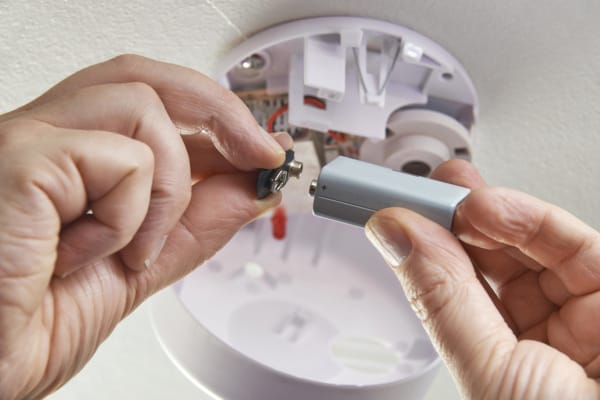
Practice safe cooking
One of the best things you can do to protect yourself from fire is to stay safe in the kitchen. NFPA’s report on home fires between 2013–2017 found that 49% of home structure fires originate in the kitchen.
A few simple steps can prevent cooking fires:
- Don’t walk away from a hot stove, especially when you’re frying
- Add food gently to hot oil, so it doesn’t splash
- Never add water to hot oil
- Extinguish small grease fires by smothering them with a lid or fire blanket
- If a fire starts inside the oven, keep the door closed and turn off the oven
Maintain gas, electric, and heating systems
After kitchen fires, NFPA found that significant causes of home fires were heating equipment (14%) and electrical distribution and lighting equipment (10%). Properly maintaining these systems is essential to prevent emergencies.
Licensed and qualified technicians should inspect heating and electrical systems before you buy a house. HVAC and gas systems should be serviced regularly according to manufacturer instructions. Again, electrical wiring and gas systems are not DIY projects. Always hire licensed, bonded, and insured tradespeople for this work. You could save a buck hiring fly-by-night workers or doing it yourself, but it’s not worth the long-term risk or a chance of electrocution, gas leaks, or equipment damage.
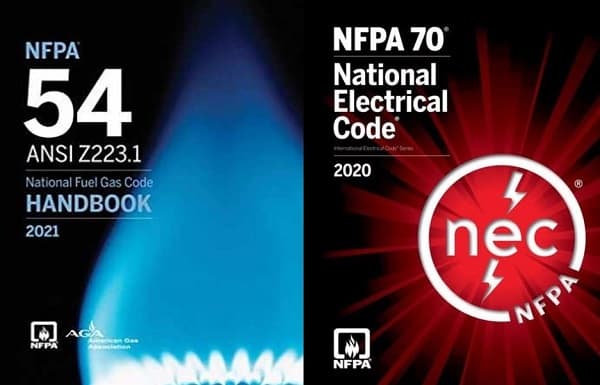
3. Making a fire escape plan
Every family needs a fire escape plan. Just like your kids have fire drills at school, you should create an evacuation plan and routinely practice drilling it at home. Here’s how:
Step 1: Know where to go
In an effective escape plan, everyone knows where to go and how to get there. To plan a fire escape route, first designate a family meeting place far enough away to be safe from smoke and fire but close enough for everyone to reach quickly. Good examples are a mailbox by the street or a neighbor’s porch.
Second, make a plan for everyone to reach that meeting place. Every family member should know how to get there from anywhere in the house—a simple thing for adults but more difficult for younger children. It’s also best to have two escape routes planned for every room in case one path is blocked by fire. For example, if you can’t use the door, escape through the window. If that window is on a higher floor, escape ladders should be bought and stored in advance.
It’s quick and easy to map out fire escape routes and a meeting place over dinner—and the kids might even enjoy it. As a family, draw a floor plan of your house showing every door and window, and don’t forget the basement. In each room, label two ways out.
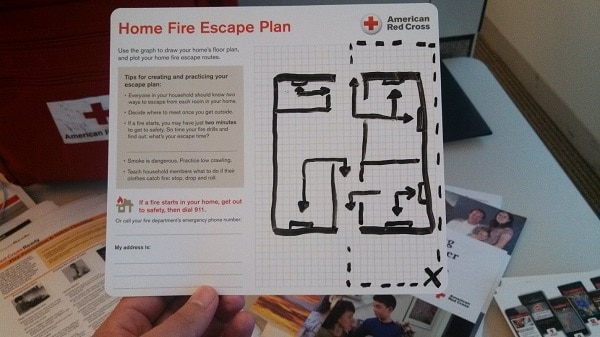
Step 2: Choose a fire captain
Every family member who can evacuate should know how to get themselves out independently. But some residents—babies, young children, the elderly, and pets—can’t save themselves easily. A fire captain is in charge of helping these people or animals get out safely. Make sure your kids know who the fire captain is, and also be sure to designate a substitute captain in case the primary person isn’t home or is overcome by smoke.
Step 3: Review fire safety basics
Do you remember the fire safety basics you probably learned in kindergarten? Make sure to review them with your family. Emphasize the following rules:
- Before going through a door, feel it with the back of your hand. If it’s hot to the touch, don’t open it!
- Stay low and crawl to get below smoke where it’s easier to breath
- “Stop, drop, and roll” if clothing catches fire
- No one should go back inside a burning building
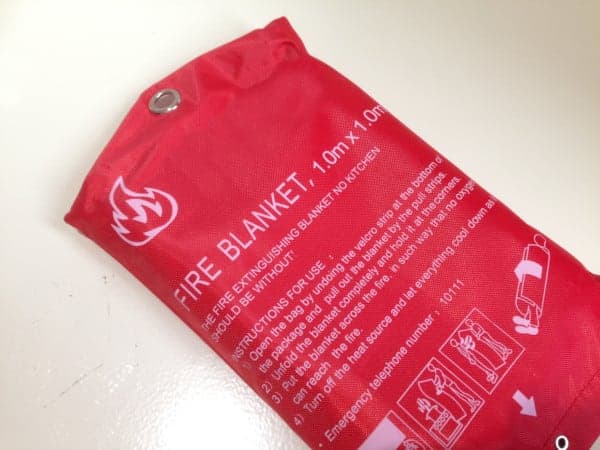
Step 5: Practice fire drills
Your kids have fire drills at school regularly—and you should practice a fire escape plan at home, too. After you’ve quizzed your children on the escape routes and meeting place, it’s time to run through the strategy.
Have the kids wait in their bedrooms for the drill to begin. One adult will be in charge of sounding the alarm and starting the fire drill. Another adult might be required to help those who need it, such as children under age six.
Press the “test” button on the smoke detector to sound the alarm and start a timer. At this point, everyone should proceed to the family meeting spot, remembering to stay low and practice testing doors for heat.
Stop the timer when everyone reaches the meeting spot. If the drill took two minutes or less, congratulate your family and consider it a success. If it took longer, keep practicing until everyone is there in under two minutes.
4. Active home fire protection measures—fire extinguishers and fire blankets
In certain situations, you can fight a fire instead of running by using a fire extinguisher or fire blanket. But you should only try to tackle a fire on your own if it’s safe to do so. Ask yourself these questions outlined by the U.S. Fire Administration:
- Has someone raised the alarm so others know about the fire?
- If necessary, has someone called the fire department?
- Is the fire small and contained (such as in a wastebasket)?
- Am I safe from smoke and fumes?
- Do I have an escape route?
- Am I physically able to use the fire extinguisher?
If you can answer yes to all these questions, you can fight the fire. To use a fire extinguisher, remember the acronym PASS:
- Pull the pin
- Aim low at the base of the fire
- Squeeze the lever slowly and smoothly
- Sweep the nozzle from side-to-side
Of course, this requires having easy, quick access to a fire extinguisher. Every home should have at least one small ABC fire extinguisher. As a general-purpose firefighting tool, an ABC is rated for ordinary combustibles (trash, wood, etc.), flammable liquids (like paint and gasoline but not cooking grease), and electrical equipment fires.
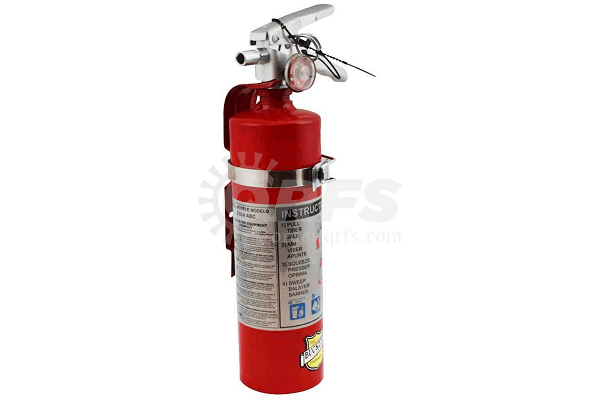
For grease fires in the kitchen, you’ll need a special K-type fire extinguisher. Read more about different types of fire extinguishers and their placement in our previous blog.
Fire blankets are valuable alternatives to fire extinguishers in some cases. You can use them to smother small fires (including grease fires in the kitchen) or clothing fires, using the blanket to supplement “stop, drop, and roll.” Additionally, a fire blanket can provide some protection for people as they escape.
Watch this video for more information on how to use a fire blanket:
For a head-to-head comparison of fire blankets and extinguishers, check out this blog.
House fires can be devastating, but preparation can prevent the worst outcomes
Home fires take hundreds of lives every year and can cause hundreds of thousands of dollars in property damage per incident. Fortunately, you can prepare yourself and your family to minimize the risk, safely escape, and quickly recover:
- Make sure your important documents and insurance are ready for an emergency
- Maintain your smoke detectors
- Be safe in the kitchen
- Ensure heating, gas, and electrical systems are in good condition
- Invest in fire extinguishers or fire blankets—and learn how to use them
- Make a fire evacuation plan and practice it!
To protect your family and home, plan ahead and have the right tools on hand.
Shop QRFS’s selection of fire blankets and ABC fire extinguishers. If you have any questions or need help choosing an extinguisher size or type, call us at 888.361.6662 or email support@qrfs.com.
This blog was originally posted at blog.qrfs.com. Check us out at Facebook.com/QuickResponseFireSupply or on Twitter @QuickResponseFS.


